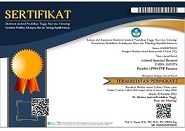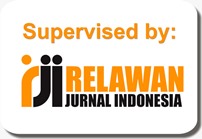A MICRO BUSINESS DEVELOPMENT MODEL THAT UTILIZES GREEN INNOVATION ANTECEDENT VARIABLES TO ENHANCE SUSTAINABLE PERFORMANCE IN MSMES LOCATED IN BINTAN REGENCY
Abstract
Full Text:
PDFReferences
Aguilera-Caracuel J, Ortiz-de-Mandojana N. Green Innovation and Financial Performance: An Institutional Approach. Organ Environ. 2013 Dec;26(4):365–85.
Albort-Morant G, Leal-Millán A, Cepeda-Carrión G. The antecedents of green innovation performance: A model of learning and capabilities. J Bus Res. 2016 Nov 1;69(11):4912–7.
Alghamdi, A. A., & Bayaga, A. (2021). Digital literacy, digital competence and emotional intelligence in higher education: A study during the COVID-19 pandemic. Education and Information Technologies, 26, 3441–3460.
Andreassen, C. S., Pallesen, S., & Griffiths, M. D. (2017). Facebook addiction: A study of personality and psychological well-being. Psychological Reports, 110(2), 501–517. https://doi.org/10.2466/02.09.18.PR0.110.2.501
Arnett, J. J. (2000). Emerging adulthood: A theory of development from the late teens through the twenties. American Psychologist, 55(5), 469.
Baeshen Y, Soomro YA, Bhutto MY. Determinants of Green Innovation to Achieve Sustainable Business Performance: Evidence From SMEs. Front Psychol. 2021 Nov 18;12.
Brown, T., & Dacin, P. (2020). The dark side of corporate social responsibility: Image management and greenwashing in practice. Business & Society Review, 125(2), 123–140.
Budi;, Sundiman D. Pengaruh Inovasi Hijau Terhadap Kinerja Berkelanjutan: Peran Moderasi Dari Kepedulian Lingkungan Manajerial (Studi Pada UMKM di Batam). DeReMa (Development of Research Management): Jurnal Manajemen. 2021;16(1).
Chakraborty, P., et al. (2020). Impact of COVID-19 on the mental health of students: A comparative study. Asian Journal of Psychiatry, 54, 102260. https://doi.org/10.1016/j.ajp.2020.102260
Chen YS. The Driver of Green Innovation and Green Image: Green Core Competence. Source: Journal of Business Ethics. 2008;81(3):531–43.
Chin, W. W. (2010). How to write up and report PLS analyses. In Handbook of Partial Least Squares (pp. 655–690). Springer.
Creswell, J. W. (2014). Research Design: Qualitative, Quantitative, and Mixed Methods Approaches (4th ed.). SAGE Publications.
Darwish, D. (2025). Artificial Intelligence Implementation in Education Processes. Google Books.
Demetrovics, Z., et al. (2008). The development of the Problematic Internet Use Questionnaire. Behavior Research Methods, 40(2), 563–574.
Elhai, J. D., Dvorak, R. D., Levine, J. C., & Hall, B. J. (2019). Problematic smartphone use: A conceptual overview and systematic review of relations with anxiety and depression psychopathology. Journal of Affective Disorders, 207, 251–259.
Fandy Kusuma A, Muafi. Pengaruh Green Organizational Culture Terhadap Competitive Advantages Karyawan: Peran Mediasi Green Innovation Behaviour. Jurnal Manajemen dan Akuntansi. 2024;19(2):462–74.
Firdausyi IA, Lestari ER, Dania WAP. Analisis anteseden inovasi hijau terhadap kinerja berkelanjutan pada UMKM berbasis pangan di Kediri Raya. Agrointek : Jurnal Teknologi Industri Pertanian. 2023 Feb 20;17(1):114–22.
Galioto, M., Pedone, F., & Vantarakis, A. (2025). University, social media, and student engagement. Frontiers in Communication. https://doi.org/10.3389/fcomm.2025.1546333
Garcia, R., & Mendez, J. (2020). Green innovation and firm performance: Contingent effects of business strategy. Journal of Cleaner Production, 258, 120852.
Goleman, D. (2006). Social Intelligence: The New Science of Human Relationships. Bantam Books
Hair, J. F., Hult, G. T. M., Ringle, C. M., & Sarstedt, M. (2021). A Primer on Partial Least Squares Structural Equation Modeling (PLS-SEM). SAGE.
Hair, J. F., Ringle, C. M., & Sarstedt, M. (2019). Partial Least Squares Structural Equation Modeling. European Business Review, 26(2), 106–121.
Henseler, J., Ringle, C. M., & Sinkovics, R. R. (2009). The use of PLS path modeling in international marketing. Advances in International Marketing, 20, 277–320.
Huang, L., et al. (2023). Understanding online learning engagement: A cross-cultural comparative study. Computers & Education, 191, 104628.
Johnson, R., & Smith, L. (2022). Environmental policy dynamics and corporate sustainability: Revisiting the moderating role of external conditions. Business Strategy and the Environment, 31(7), 2762–2775.
Kline, R. B. (2015). Principles and Practice of Structural Equation Modeling (4th ed.). Guilford Press.
Kunapatarawong R, Martínez-Ros E. Towards green growth: How does green innovation affect employment? Res Policy. 2016 Jul 1;45(6):1218–32
Kuss, D. J., & Griffiths, M. D. (2017). Social networking sites and addiction: Ten lessons learned. International Journal of Environmental Research and Public Health, 14(3), 311.
Lee, K., & Shin, D. (2019). Corporate social responsibility and green innovation: The role of proactive environmental strategy. Journal of Business Ethics, 158(1), 1–18
Li H, Li Y, Sarfarz M, Ozturk I. Enhancing firms’ green innovation and sustainable performance through the mediating role of green product innovation and moderating role of employees’ green behavior. Economic Research-Ekonomska Istrazivanja . 2023;36(2).
Li, L., Wang, Y., Sun, H., Shen, H., & Lin, Y. (2023). Corporate Social Responsibility Information Disclosure and Financial Performance: Is Green Technology Innovation a Missing Link? Sustainability, 15(15), 11926.
Lepp, A., Barkley, J. E., & Karpinski, A. C. (2014). The relationship between cell phone use, academic performance, anxiety, and satisfaction with life in college students. Computers in Human Behavior, 31, 343–350. https://doi.org/10.1016/j.chb.2013.10.049
Matthews, B. (2022). Assessing Multigroup Measurement Invariance in PLS-SEM. International Journal of Business Research, 22(1), 21–35.
Mariawati, Dedi Mulyadi, Yanti. Pengaruh Green Innovation Dan Keberlangsungan Usaha Terhadap Kinerja Keuangan UMKM Pabrik Tahu dan Tempe Di Kabupaten Karawang. SEIKO : Journal of Management & Business. 2024;7(1):1451–63.
Montag, C., et al. (2021). The digital footprint of personality. Current Opinion in Behavioral Sciences, 38, 6–12. https://doi.org/10.1016/j.cobeha.2020.07.001
Mora-Gonzalez, J., et al. (2025). Physical activity and mental health across the lifespan. Frontiers in Psychology. https://doi.org/10.3389/fpsyg.2025.1636754
Naslund, J. A., Aschbrenner, K. A., Marsch, L. A., & Bartels, S. J. (2016). The future of mental health care: Peer-to-peer support and social media. Epidemiology and Psychiatric Sciences, 25(2), 113–122. https://doi.org/10.1017/S2045796015001067
Papageorgiou, K. A., et al. (2019). Empathy and digital communication. Personality and Individual Differences, 146, 35–40.
Pera, A. (2020). The psychology of fake news, social media, and digital narcissism. Postmodern Openings, 11(1), 39–52. https://doi.org/10.18662/po/103
Petrides, K. V., Mikolajczak, M., Mavroveli, S., Sanchez-Ruiz, M. J., Furnham, A., & Pérez-González, J. C. (2016). Developments in trait emotional intelligence research. Emotion Review, 8(4), 335–341.
Porter, M. E., & Kramer, M. R. (2006). Strategy and society: The link between competitive advantage and corporate social responsibility. Harvard Business Review, 84(12), 78–92.
Rakhmawati A, Rahardjo K, Kusumawati A. Faktor Anteseden dan Konsekuensi Green Supply Chain Management. Jurnal Sistem Informasi Bisnis. 2019 May 3;9(1):1.
Ridha, Umi Anisah H. Pengaruh Inovasi Hijau, Orientasi Kewirausahaan, dan Kompetensi Kewirausahaan Terhadap Kinerja UMKM (Studi Pada UMKM Mebel Pada UMKM Mebel di Kota Banjarmasin). Indonesian Journal of Islamic Jurisprudence, Economic and Legal Theory [Internet]. 2024;2(4):1995–2010. Available from: https://shariajournal.com/index.php/IJIJEL/
Riggio, R. E. (1989). Social Skills Inventory Manual. Consulting Psychologists Press.
Ryff, C. D. (1989). Happiness is everything, or is it? Journal of Personality and Social Psychology, 57(6), 1069–1081. https://doi.org/10.1037/0022-3514.57.6.1069
Sarstedt, M., Ringle, C. M., & Hair, J. F. (2014). Partial least squares structural equation modeling. Handbook of Market Research.
Smith, A., & Jones, B. (2021). Technological capability and sustainable innovation: A balanced approach. International Journal of Innovation Management, 25(4), 2150043.
Tang, J., Hu, X., & Zhao, Y. (2021). Digital connectivity and empathy among students. Computers in Human Behavior, 114, 106553. https://doi.org/10.1016/j.chb.2020.106553
Tseng ML, Wang R, Chiu ASF, Geng Y, Lin YH. Improving performance of green innovation practices under uncertainty. J Clean Prod. 2013 Feb;40:71–82.
Tue, F., Lasulika, C. T., Hasim, H., & Nurfaika, N. (2024). Dialektika Alam dan Manusia dalam Perspektif Geografi Sosial. Innovative: Journal Of Social Science Research, 4(6), 4844–4853.
Twenge, J. M., et al. (2018). The rise of depression and anxiety among adolescents and its link to screen time. Clinical Psychological Science, 6(1), 3–17. https://doi.org/10.1177/2167702617723376
Vaterlaus, J. M., et al. (2019). College students’ social media use and social skills. Computers in Human Behavior, 93, 25–30.
Uhls, Y. T., et al. (2014). Five days without screens improves preteen social skills: A field experiment. Computers in Human Behavior, 39, 387–392.
Wang, C., et al. (2020). Immediate psychological responses during the initial stage of the COVID-19 epidemic among the general population in China. International Journal of Environmental Research and Public Health, 17(5), 1729.
Wang H, Khan MAS, Anwar F, Shahzad F, Adu D, Murad M. Green Innovation Practices and Its Impacts on Environmental and Organizational Performance. Front Psychol. 2021 Jan 18;11.
Xiong, J., et al. (2020). Impact of COVID-19 pandemic on mental health. Journal of Affective Disorders, 277, 55–64. https://doi.org/10.1016/j.jad.2020.08.001
Yahya S, Khan A, Farooq M, Irfan M. Integrating green business strategies and green competencies to enhance green innovation: evidence from manufacturing firms of Pakistan. Environmental Science and Pollution Research. 2022 Jun 1;29(26):39500–14.
Zhang, Y., Sun, J., Yang, Z., & Wang, Y. (2020). Critical success factors of green innovation: Technology, organization and environment readiness. Journal of Cleaner Production, 264, 121701. https://doi.org/10.1016/j.jclepro.2020.121701
DOI: https://doi.org/10.31846/jae.v13i3.993
Refbacks
- There are currently no refbacks.

This work is licensed under a Creative Commons Attribution-NonCommercial-NoDerivatives 4.0 International License.
e-Jurnal Apresiasi Ekonnomi Indexed by:












